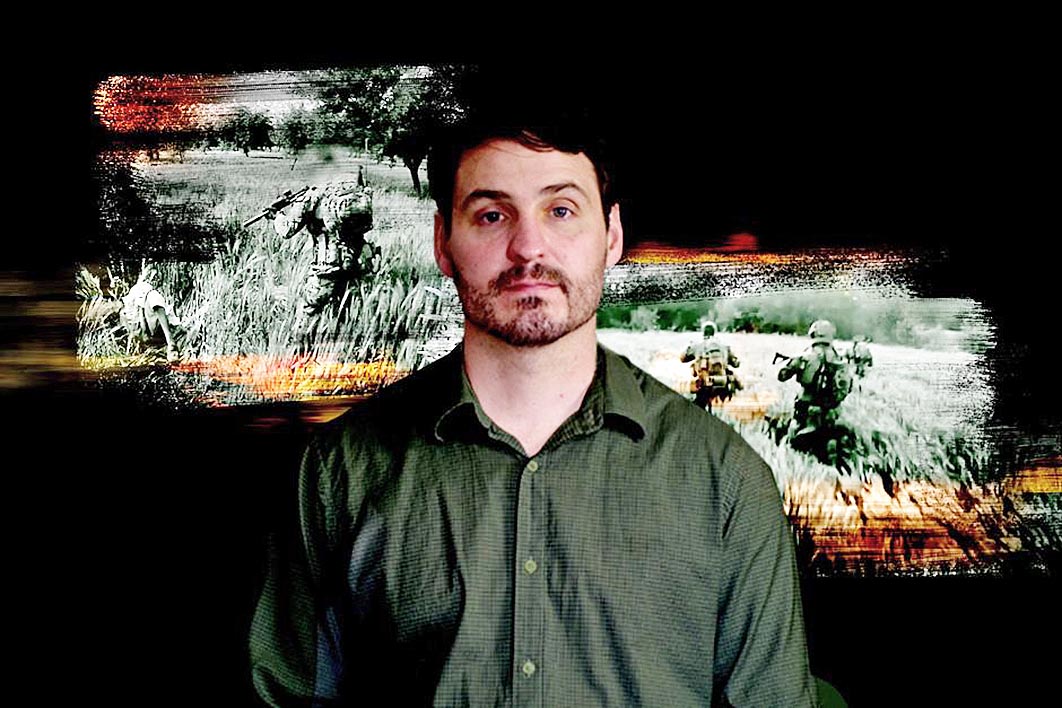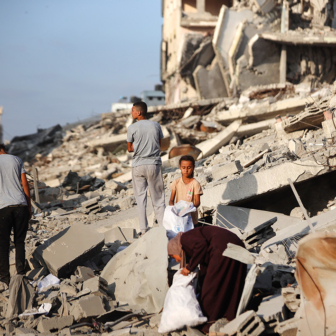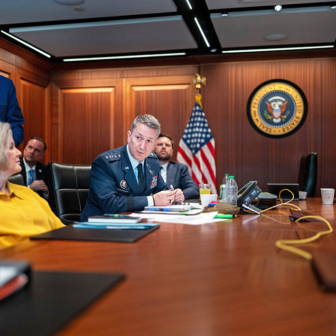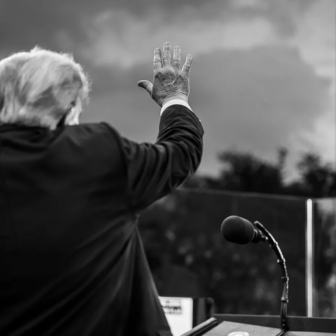Twenty-twenty was going to be a year of Good Vision for Life, according to a campaign mounted in January by Optometry Australia. Like most of us, they didn’t see what was coming. Nor, I imagine, did the team at Four Corners, but that didn’t stop them from tracking the chaotic events we were subjected to during the year. A look back at its coverage is a chance to bring some hindsight to bear on the failures of foresight…
Not that they were failures for which blame could always be attributed. The limits of human vision and agency must be confronted in any disaster, and Black Summer, the first episode of the year, presented the confrontation as a very immediate ordeal, terrifying to witness even in its aftermath. The program was introduced by Hamish Macdonald, who was himself caught up in the unfolding catastrophe in Cobargo on the NSW south coast, and footage was provided by people struggling to get their bearings in the midst of the inferno. With sparks flying from all directions as the fire front approached in the opening scene, a voice-over at least provided reassurance that we were in the presence of a survivor: “The sky was changing colour… It just got darker and darker and darker.”
“There are known unknowns,” as Donald Rumsfeld famously said, “and there are also unknown unknowns.” The fires were a known unknown. Rural fire brigades knew that conditions were stacking up for a worst-case scenario; fire chiefs issued dire warnings to the government. But no one could know how, when or where the emergency would present itself. When outbreaks began to multiply, news commentators spoke of “uncharted territory.” As for dealing with the human aspects of the tragedy, Shane Fitzsimmons, head of the NSW Rural Fire Service, put it best: “there’s no rule book, no script, no guide.”
The fire itself was a demon of unpredictability, changing course, creating its own weather, eliminating so many features of the natural world that people trying to flee couldn’t see or hear anything else. Vehicles were driven in conditions of near-zero visibility; a fallen tree across the road could prove fatal.
Twenty-twenty vision is a luxury we don’t always have, and having to do without anything resembling it was one of the lessons of the bushfires. “It’s going to be a turning point for everyone in Australia and a lot of people worldwide as well,” said a Kangaroo Island survivor in the closing moments of the program.
If that’s the case, we have yet to reckon with it. Hard Winter, a follow-up on bushfire recovery screened in June, showed the communities of Cobargo, one of the worst-affected areas, struggling on their own. A couple are seen pulling a tarpaulin over a makeshift shelter on a property surrounded by blackened trees. With no running water, they must drive to the village to take showers. Fuel is a scarce commodity. Five months on, basic needs were still not being met.
The government bodies, charities and services supposed to be helping were simply not equipped to respond adequately, and had failed to factor in the psychological gap. Presenting application forms to traumatised people who have lost everything is crassly inappropriate; a $50,000 rebuild grant for an uninsured farmer living amid the burnt-out ruins of a lifetime’s work is cruelly inadequate. Post-traumatic stress may kick in several months after the event, once the mental health counsellors have packed up and left.
But the turning point seemed not to have registered in the national psyche. Only those at the centre of the disaster were facing up to a changed reality. “We’ve lost our innocence, our ‘she’ll be okay mate,’” said a local business owner. “Because it’s not. And it won’t ever be.” “Be with us. Work with us. Stay with us,” another resident pleaded. Some have stuck around, like the volunteer backpackers who helped a farmer replace kilometres of fencing, but elsewhere other concerns were coming to the fore.
By late February, the pandemic was taking over from the bushfires as the crisis of the year. In Coronavirus (24 February), Sean Nicholls reported from Wuhan with footage of a deserted metropolis that presaged what was to come in cities around the world, though at the time it seemed an extreme symptom of some alien regime of power. The virus was another known unknown, with comparisons to be made with SARS, HIV/AIDS, Ebola and the Spanish flu.
If there were any unknown unknowns, they were in its place of origin — this great oriental city under the control of a government increasingly perceived as hostile and secretive. What was really going on in those sinister scenes of white-suited men hauling citizens out of their houses and bundling them into official vehicles? Terrified residents found themselves locked in their apartment buildings; people were said to be dropping dead in the streets; doctors were being threatened for sharing information about cases they were seeing.
Xi Jinping had lost control of the narrative, said the Lowy Institute’s Richard McGregor. And as for the infection rate and mortality numbers, who knew for sure? According to Neil Ferguson, professor of epidemiology at Imperial College in London, up to an estimated 50,000 people were being infected each day in China. Official figures were reckoned to reveal less than 10 per cent of the actual rates. If the Chinese government was underestimating at that stage, Ferguson’s numbers were wildly overestimated.
In hindsight, the program had some troubling elements of xenophobia. How different does all this look when we take the Orientalism out of the picture — when it is the deserted streets of Paris and Rome on our screens; when the US administration has lost control of the narrative; when an apartment block in Melbourne is suddenly cordoned off and Sky News stirs up alarm about Dictator Dan?
Pandemic (30 March), was the first attempt to report on the virus from an Australian perspective. Sean Nicholls, again the principal reporter, opened by announcing that Australia, like much of the world, was “on a war footing.” Norman Swan, reporting from the frontline, was measured and genuinely informative, as he has been throughout the pandemic, but the spectre of disaster on an unpredictable scale loomed.
Every infected person would infect two others, said Sharon Lewin, director of the Doherty Institute. That is theoretically possible, though not a standard expectation by any means. As the program went to air, the Ruby Princess debacle was unfolding and the prime minister had been forced to do a swift reversal on pronouncements made two weeks earlier about freedom to go to the footy. On social media, “2020 vision” was becoming a bad joke.
As might be expected, the pandemic dominated the Four Corners agenda for the rest of the year. Episodes focused on the financial implications, on the Ruby Princess, on vaccine research, on the second wave, on infection spread in aged care facilities, and on the impact of school closures on Year 12 students. As the year progressed, reporting became less speculative, less foreboding and more focused on the specific ways in which the pandemic’s impact was being experienced.
Students interviewed for The Class of 2020 (2 November) talked of how the lockdown had brought them to reflect on their futures in sterner ways. A confrontation with the unexpected can create a steep learning curve. “This year targeted everything I took for granted,” said Joseph Hathaway-Wilson. Like the woman in Cobargo who spoke of a lost innocence, these students were coming to terms with the limits of human foresight.
Those limits can be a challenge for even the most hard-bitten investigative reporters. A Careful War, a two-part series on the war in Afghanistan originally broadcast in 2010, was promoted again on the Four Corners site earlier this year. It was a remarkable piece of reporting by Chris Masters, embedded with Australian Special Forces troops, who provided live documentation of engagements with the Taliban, including an incident in which two Australian soldiers were killed by an improvised explosive device.
This was the blackest day for Mentoring Team Alpha, which was on a mission to provide security and reconstruction to communities in the remote Mirabad Valley. At the start of the enterprise, morale was high. “Shifting schisms and alliances” was the name of the game and, as commanding officer major general John Cantwell put it, it was not one for sledgehammer tactics: “It requires understanding, nuance, and a sense of affiliation.”
It also requires stepping carefully across every metre of ground. What the troops could not determine, often because the locals wouldn’t tell them, was where the explosive devices were buried. Always, there are known unknowns. And for Masters himself, there was a residual awareness of another side to the military story, which he has subsequently taken a lead role in exposing. The darker picture emerged with devastating impact in Killing Field (16 March), based on footage captured by soldiers in Afghanistan. Mark Willacy obtained extensive interviews, most notably with Braden Chapman, an operative deployed with the elite Special Forces in 2012.
From the opening frames, with a soldier’s voice shouting “Get the fuck out!” while frightened civilians were herded from their homes, it was clear we were in a very different environment from the one Masters had documented. Everything was reversed. Here, it was the Australians who were the danger to local communities, and the soldiers themselves had little to fear. “You definitely feel confident with these guys,” said Chapman, “I never felt like we weren’t gonna get through it.”
Chapman is an impressive witness, determined to say what needs to be said despite not knowing how he will get through whatever may be in store for a whistleblower. He had distressing stories to tell, in detail, and the program-makers illustrated them with expertly edited footage that gave a sense of events unfolding in real time.
By the time the episode went to air, allegations of war crimes committed by Australian Special Forces were the subject of an inquiry by NSW Supreme Court judge Paul Brereton. Four Corners reporting, and the work of Masters and Willacy in particular, has a prominent place in the log of evidence.
Amid the global crises and the mounting chaos in the United States, domestic politics registered less strongly than usual on the current affairs radar. With little to be reported from a deserted Parliament House, Louise Milligan’s attempt to portray the building as a scene of scandalous affairs in Inside the Canberra Bubble (9 November) was ill-timed. Why at this moment, when the fallout from the US presidential election was dominating the news, the second wave of the pandemic was building across the globe, and fears of an economic depression were being rehearsed in the press?
It’s not that the issues lacked importance. But the program was made up of a jumble of concerns about personal behaviour, the professional culture of Parliament House (or lack of it), the proportion of women on the frontbench, sexual discrimination and workplace management. The behaviour of senior ministers raises one set of concerns; how workplace conditions are managed and regulated raises another. Why was there no interview with the Clerk of the Senate, who has oversight of human resources?
The program was poorly structured, strung together with a mish-mash of visual footage that might have been assembled from discarded offcuts. Ominous music accompanied panoramic shots of night-time Canberra. The camera peered up the hill towards Parliament House at dusk. Headlights swerved in the darkness. A full moon loomed. All this created a portentous mood, as if to suggest that Canberra is a sinister place and Parliament House — “a bubble within a bubble,” as Malcolm Turnbull put it — a secretive bastion where all manner of things go on.
As for what was actually happening inside the building, the answer was not much, at least at the time. Close-up shots of feet walking down corridors became a kind of leitmotif. They were anonymous and out of focus, and there were high heels in the mix, evoking a stereotyped female corporate look. A few days after the program went to air, it was a relief to see Penny Wong being presented by her colleagues with a birthday present of Converse sneakers of the kind worn by Kamala Harris.
Four Corners doesn’t often fall short in its endeavours. The program continues to make an essential contribution to national affairs. Time and again it has broken stories that spark major public enquiries and legislative changes, and this year was no exception. It’s in periods of turmoil and crisis that its role is most valuable. No government should be allowed to put such work at risk. •




